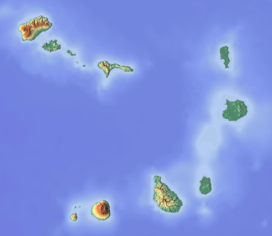Pico do Fogo
| Pico do Fogo | |
|---|---|
 |
|
| Highest point | |
| Elevation | 2,829 m (9,281 ft) |
| Prominence | 2,829 m (9,281 ft) Ranked 120th |
| Isolation | 1,674 kilometres (1,040 mi) |
| Listing |
Country high point Ultra List of mountains in Cape Verde |
| Coordinates | 14°57′00″N 24°20′30″W / 14.95000°N 24.34167°WCoordinates: 14°57′00″N 24°20′30″W / 14.95000°N 24.34167°W |
| Geography | |
|
|
|
| Geology | |
| Mountain type | Somma volcano |
| Last eruption | November 2014 to February 2015 |
Pico do Fogo pronounced: [ˈpiku du ˈfoɡu] is the highest peak of Cape Verde, rising to 2,829 metres (9,281 ft) above sea level. It is an active stratovolcano lying on the island of Fogo. The main cone last erupted in 1675, causing mass emigration from the island. A subsidiary vent erupted in 1995. The only deadly eruption was in 1847 when earthquakes killed several people.
Fogo is a hotspot volcanic island. Its most recent eruptions have occurred in 1951, 1995 and 2014. It is the youngest and most active volcano in the Cape Verde Islands, a short chain of volcanic islands that generally are younger at the western end, formed as the African Plate moved towards the east over the hotspot.
Fogo consists of a single volcano, so the island is nearly round and about 25 kilometers (16 mi) in diameter. The large summit caldera (about 10 kilometers in the north-south direction and 7 kilometers in the east-west direction) is not located in the center of the island, but rather towards its northeastern corner. The caldera is bounded by steep near-vertical fault scarps on the north, west, and south sides but is breached to the east where lava can flow to the coast. North-northeast-trending eruptive fissures opened along the western flank of Pico, which formed inside the caldera between about 1500 and 1760. The last eruption from the top was in 1769. The current topography of Fogo, with the caldera open to the sea on the east side, results from the sliding of the east flank of the volcano towards the ocean.
The mountain's slopes are used to grow coffee, while its lava is used as building material. Near its peak is a caldera and a small village, Chã das Caldeiras, is inside this caldera.
...
Wikipedia

